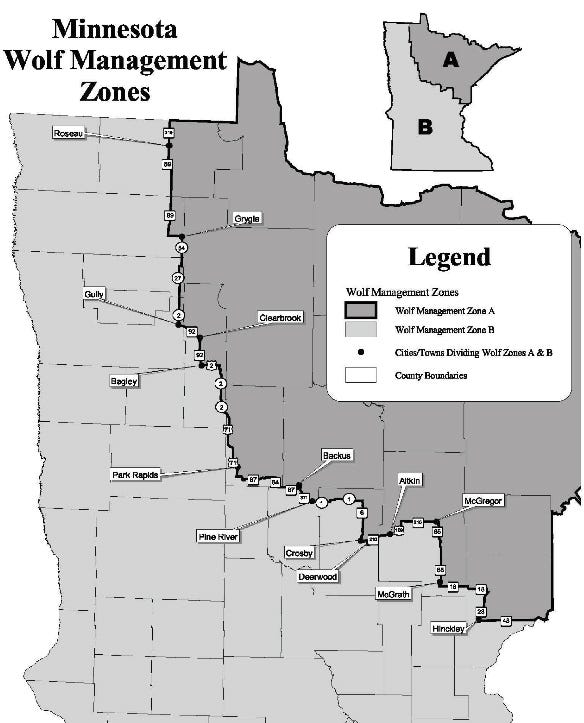
While the federal Endangered Species Act protections for wolves ended Jan. 4, Minnesota laws continue to protect wolves and provide stewardship guidance.
Minnesota, which has the largest wolf population in the lower 48 states, is home to an estimated 2,700 wolves across nearly 40,000 square miles of northern and central Minnesota, according to the state’s Department of Natural Resources.
Per existing state law, Minnesota recognizes two wolf management zones. Zone A, the northeastern part of the state, has more protections for wolves, while Zone B, which represents the southern two-thirds of the state, has more flexibility for people to manage wolves to protect livestock and pets.
 MANAGEMENT PLAN UPDATE: Minnesota’s wolf management plan, written in 2001, is getting updated by the DNR. Last year, a 20-member advisory committee gave input on revisions.
MANAGEMENT PLAN UPDATE: Minnesota’s wolf management plan, written in 2001, is getting updated by the DNR. Last year, a 20-member advisory committee gave input on revisions.

In Zone A, state law allows owners of livestock, guard animals or domestic animals to shoot or destroy wolves that pose an immediate threat to their animals on property they own or lease, in accordance with local statutes. “Immediate threat” means the owner observed a wolf in the act of stalking, attacking or killing livestock, a guard animal or a domestic pet under the supervision of the owner.
In all cases, a person shooting or destroying a wolf under these provisions must protect all evidence and report the taking to a DNR conservation officer within 48 hours. The wolf carcass must be surrendered to the conservation officer.
In Zone B, a person may shoot a wolf at any time to protect livestock, domestic animals or domestic pets on land they own, lease or manage. The “immediate threat” circumstance does not apply. The owner must notify a DNR conservation officer within 48 hours of taking the wolf and must surrender the wolf carcass to the conservation officer.
People in Zone B also may employ a state certified wolf predator controller to trap wolves on or within 1 mile of land they own, lease or manage.
The DNR is in the process of updating the 2001 state wolf management plan and held virtual public hearings last fall to gather public comments. The Minnesota State Cattlemen’s Association was one of several farm organizations that offered comments and worked on the agency’s wolf plan advisory committee. Jake Thompson, MSCA vice president and cow-calf producer, served on the committee.
“The MSCA hopes for our current Minnesota wolf management plan to be enhanced with asks including a trapping season, and steady funding for the indemnity program and the staff in an effort to streamline the program and have a more consistent payment rate across the state,” says Allison VanDerWal, MSCA executive director. “We are also advocating for more funding for larger grants for producers to install nonlethal barriers to protect their livestock. Like everyone, the MSCA wants the updated wolf management plan to be a success in the state of Minnesota, where wolves and livestock thrive and coexist.”
Prevention grant deadline
Livestock owners have until Jan. 15 to apply for a state Wolf-Livestock Conflict Prevention Grant. The grants were first funded by the Minnesota Legislature in 2017 with $240,000 to be administered by the Minnesota Department of Agriculture. The grants were to be used to reimburse livestock producers for costs of approved practices to prevent wolf-livestock conflicts between July 1, 2017, and June 30, 2019.
Last fall, MDA received a grant from the U.S. Fish and Wildlife Service to continue making grants to livestock producers for measures that will reduce wolf-livestock conflicts. A total of $60,000 is available for 2021.
Like the previous rounds of grants, eligible expenses for the grant program will include any or all of the following items: purchase of guard animals; veterinary costs for guard animals; the installation of wolf barriers which may include pens, fladry and fencing; the installation of wolf-deterring lights and alarms; calving or lambing shelters; and other measures demonstrated to effectively reduce wolf-livestock conflicts.
New this year, grants must be matched 1-to-1 by producers. For example, a $10,000 project would consist of $5,000 in grant funds and $5,000 funded by the producer. Documentation must be provided to MDA for the entire amount spent on the project. For this example, that would be $10,000.
Grant applications will be scored competitively using an evaluation profile and then ranked based on total score. Grant applications must be emailed or postmarked by 5 p.m. Jan. 15.
MDA is not responsible for any email problems resulting in MDA not receiving a proposal on time. It is the responsibility of the responder to ensure that any email submittals are received by MDA before the deadline.
Applicants will be notified of the status of their application by MDA in mid-March. Approved projects should be able to begin by mid-April.
For more information about wolves, visit the DNR wolf management page. To learn more about the plan update, visit Updating Minnesota’s wolf plan. To apply for a Wolf-Livestock Conflict Prevention Grant, visit mda.state.mn.us/wolf-livestock-conflict-prevention-grants.
About the Author(s)
You May Also Like






